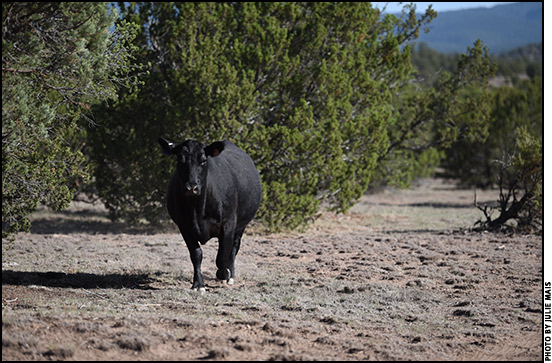MANAGEMENT...

Rangeland Heifer
Selection
and Development
Heifer size not the best tool for selecting heifers for longevity.
Heifers should have their first calf by the age of 2 years. However, that is dependent on their reaching puberty early, and puberty is a function of age and body weight, noted Bruce Carpenter, Texas A&M University animal science associate professor and extension livestock specialist, speaking to cattlemen gathered Aug. 29-30 in Ruidoso, N.M., for the Applied Reproductive Strategies in Beef Cattle workshop.
Heifers born in the first half of the calving season should be more physiologically mature and thus more likely to be pubertal. However, Carpenter pointed out, a lot of mitigating circumstances often make this a flawed and inefficient approach.
One of the most challenging aspects of selecting heifers is knowing on what to base selection. In an ideal world, it would solely be on birth date, selecting the heifers born earliest in the calving season as a sign of early fertility. Read more.
Hurricane Aftercare
Tips offered on caring for animals after the storm hits.
While parts of the country are dealing with no water, others are dealing with too much and severe wind damage. Hurricanes cause incredible amounts of damage. Being prepared is the best prescription for dealing with hurricanes. However, since hurricane season is in full swing, it is important to know how to care for animals after the storm.
Clemson University’s Livestock Poultry Health (CULPH) department says human life and safety will be the first priority, but there will be systems in place at the county and state level to assist people with animals and agricultural businesses affected by the storm, including donations of hay, equipment and volunteer personnel. The first place to contact is your county emergency management department (EMD). Read more.
Drought Secret Weapon
Improve low-quality forages with ammonia treatment.
Livestock producers can stretch short supplies of hay this year by using a simple ammonia treatment on bales, says University of Missouri (MU) Extension agronomist Rusty Lee.
Lee says ammoniation boosts the nutritive value of poor-quality hay and makes it more digestible for cows and horses.
Craig Roberts, MU Extension state forage specialist, calls ammoniation a “secret weapon” in drought-stressed areas. With proper ammoniation, the nutritional value of hay, cornstalks and straw can improve significantly, even double, at a reasonable cost.
Lee says it is important to ammoniate only poor-quality hay. Higher-quality grass hay can become toxic with nitrates after ammonia treatment and cause “crazy cow” syndrome when fed. A maximum rate of 50 pounds (lb.) of anhydrous ammonia per ton of straw should be observed to avoid nitrate issues. Read more.
Developing for Longevity
Management decisions affecting reproduction and longevity in the Southwest.
“Profitability of the beef cow producer is directly tied to the longevity of the cow,” said Adam Summers, New Mexico State University assistant professor of animal science. Cows need to produce a calf yearly for at least three years to recoup their cost of development as a heifer.
The “ideal” cow is developed at a low cost to reach puberty early and breed at the earliest opportunity. She is expected to produce a calf unassisted every year and to take care of that calf by teaching it instincts and providing adequate nutrition while remaining sound, sane, disease-resistant and thriving in her environment. Producers also expect her to retain her value when she is culled at the end of her productive life.
“We expect a lot out of our cows,” Summers said, leading into a discussion of the influence calving date plays on cow longevity during the Applied Reproductive Strategies in Beef Cattle workshop hosted in Ruidoso, N.M., Aug. 29-30. Read more.
Injection Pointers
Proper injections reduce residues, lesions and risks.
Injections — vaccines, antibiotics, medications to help reduce inflammation, injectable vitamins or minerals, etc. — should always be administered properly to minimize residues and injection-site lesions, and to reduce risks for reactions and side effects.
Shannon Williams, Lemhi County Extension educator in Salmon, Idaho, says it’s important to read labels. Vaccine companies sometimes update their labels. Dosage or injection sites may change. Something that was given intramuscularly (IM) or with an option for IM or subcutaneous (SubQ) injection may now be labeled for subcutaneous only.
Producers must use vaccines and antibiotics properly because of our commitment to consumers to provide a safe product. Read more.

Kris Ringwall
Beef Talk
‘500 Club’ reached in 2018 cow-calf production benchmarks.
Commercial beef producers joined the “500 Club” in pounds weaned per cow exposed, according to the 2018 Cow Herd Appraisal Performance Software (CHAPS) records.
The new benchmark is 502 pounds (lb.) and illustrates better understanding of benchmarks. This knowledge is critical, because it allows producers to gauge, adjust and keep track of cattle production based on long-term benchmarks within the industry. Read more.
Angus Advisor
Click here for October herd management tips from cattle experts across the nation. Advice separated by region.
[Click here to go to the top of the page.]






